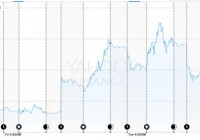Grexit Or Not, Buy These 3 European ETFs
The Greece predicament was at its worst last weekend, leading many to believe that its debt drama has climaxed. As the deal talk collapsed, prime minister Alexis Tsipras was forced to close the country’s banks for this entire week and impose capital controls. Daily withdrawals from automated teller machines was limited at 60 euros in an all-out attempt to prevent catastrophe. The breakdown has put Greece on the brink of a default, as the $1.8-billion payment to the International Monetary Fund (IMF) that was scheduled for June 30 will finally not be made. The fate of Greece’s eurozone membership now depends on Tsipras and his last-ditch efforts. A New Twist in the Greek Crisis The crisis took a dramatic turn when Tsipras called a snap referendum on July 5, wherein Greek citizens will have to vote for or against the terms of a bailout deal proposed by the country’s creditors – IMF, European Union and the European Central Bank (ECB). The prime minister called the referendum because the creditors are demanding tough economic policies, such as drastic tax hikes and sharp cuts to government spending, including pension cuts, in exchange for rescue funds. The government found the deal “humiliating”, and is urging all Greek citizens to vote against the proposal in the referendum so that it could open the doors for desirable bailout negotiations. Tens of thousands of protesters are out on the streets to back the government’s rejection of a tough international bailout. The latest news from the Greek front is that its finance minister Yanis Varoufakis has ruled out any possibility of paying an IMF installment, while Tsipras is trying again to work out a last-minute deal with the creditors. Even if Tsipras’ efforts in the eleventh-hour fail and Greece is compelled to exit eurozone, there would actually be not much to panic about. This is because the European financial system now has much less exposure to the cash-strapped Greece than it had in 2011 and 2012. Grexit concerns sent the Greek stock market into a free-fall territory on Monday’s trading session. The Global X FTSE Greece 20 ETF (NYSEARCA: GREK ), the only ETF targeting the Greek stock markets, fell 19.4% on a single trading day. The contagion has also spread worldwide. While Asia and the U.S. felt a ripple effect, the European stocks were the hardest hit (see: all the European ETFs here ). The blue-chip Euro STOXX 50 Index dropped as much as 5% on the day, representing the biggest one-day drop since 2011, led by countries having high debt and austerity policies. Investors could wait on the sidelines until the crisis drags the stocks. And when the cloud clears, the beaten-down prices might point to solid buying opportunities for many stocks and ETFs, irrespective of Greece’s withdrawal from or place in the eurozone. Further, the ECB is still pumping billions of dollars into the economy. And if this continues, the stocks might get a huge boost in the coming months. We can’t foretell whether Greece will win this debt battle like its heroic ancestors in the nick of time, but we do predict three European ETFs as having huge upside potential at the end of this drama. These funds have a top Zacks ETF Rank of 2 or a “Buy” rating, suggesting their outperformance over the coming months: First Trust Eurozone AlphaDEX ETF (NASDAQ: FEUZ ) This fund provides exposure to the eurozone stocks by tracking the NASDAQ AlphaDEX Eurozone Index, and employs an AlphaDEX methodology. It ranks stocks in the space by various growth and value factors, eliminating the bottom-ranked 25% of the stocks. This approach results in a basket of 150 stocks that are widely spread out across various components, with none holding more than 1.37% of assets. The fund is also spread out across sectors, with consumer discretionary, industrials, financials, utilities and materials taking the top five spots with double-digit exposure each. In terms of country allocations, Germany and France are leading with 23.3% and 22% share, respectively, followed by Italy (11.2%) and Spain (10.3%). FEUZ is unpopular and less liquid in the broad European space, with AUM of $15.3 million and average daily volume of around 141,000 shares. The expense ratio came in at 0.80%. The fund was down 3.1% in Monday’s trading session. iShares MSCI Italy Capped ETF (NYSEARCA: EWI ) This ETF tracks the MSCI Italy 25-50 index holding 26 Italian firms in its basket. It is heavily concentrated on the top two firms, Eni and Intesa Sanpaolo, with a combined 23.5% share, while other securities hold less than 8% of the total assets. Further, about 40% of the fund’s portfolio is allotted to financials from a sector look, while energy, utilities, industrials and consumer discretionary round off the top five with double-digit exposure each. The fund has amassed $1.1 billion in its asset base, and trades in heavy volume of more than 7.5 million shares a day, on average. It charges 48 bps in annual fees and lost 5.6% on Monday trading, making it attractively valued at the current levels. iShares MSCI Germany ETF (NYSEARCA: EWG ) This fund targets the German equity market and tracks the MSCI Germany Index. It is by far the largest and most popular German ETF, with AUM of over $7.5 billion and average daily volume of 5.5 million shares. The fund has an expense ratio of 0.48%. Holding 55 stocks in its basket, EWG is skewed toward the top firm – Bayer ( OTCPK:BAYZF ) – at 10%, while other firms hold no more than 7.58% of the assets. From a sector look, industrial takes the top spot at 22%, while financials, healthcare, materials and industrials make for double-digit allocation each. The ETF lost about 4% on the day. Original Post

